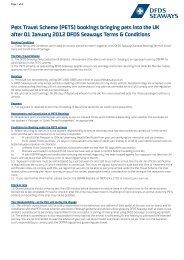TEL: 08715 747218 - DFDS Seaways
TEL: 08715 747218 - DFDS Seaways
TEL: 08715 747218 - DFDS Seaways
You also want an ePaper? Increase the reach of your titles
YUMPU automatically turns print PDFs into web optimized ePapers that Google loves.
Les Braves,<br />
Omaha Memorial<br />
Image: Clive Frankham<br />
Field Marshal Montgomery<br />
returned from his successes in<br />
North Africa to head up land<br />
operations in Normandy under<br />
General Eisenhower. Having<br />
selected the Normandy beaches<br />
for a secret landing, tides had to<br />
be reckoned with and 5th June<br />
was chosen. However weather<br />
conditions at the last moment<br />
meant a postponement of<br />
24 hours. The first airborne<br />
landings took place at Ranville<br />
where gliders of the 6th<br />
Airborne Division dropped<br />
silently onto the strip of<br />
land between the River Orne<br />
and the Caen Canal to take<br />
the bridges.<br />
The full seaborne invasion<br />
was along the coastline of<br />
Calvados, from Ouistreham<br />
to half way up the Cherbourg<br />
Peninsular. The beaches were<br />
given names and the US Army<br />
landed at ‘Utah’and ‘Omaha’<br />
while the British took ‘Gold’<br />
and ‘Sword’ with the Canadians<br />
landing at ‘Juno’. By the end<br />
Troops of the U.S. Army's<br />
1st Infantry Division on the<br />
morning of 6th June 1944<br />
(D-Day) at Omaha Beach.<br />
of the day the Allies had landed<br />
some 155,000 men (including<br />
26,000 by air) with more than<br />
1,000 guns and vehicles.<br />
Casualties amounted to 10,000<br />
men, largely at Omaha.<br />
The objective to liberate<br />
Caen within days of landing<br />
was not achieved, due to fierce<br />
resistance, until early July,<br />
causing wide destruction to the<br />
city. Meanwhile, the American<br />
troops were to spread out to cut<br />
off the ports of Cherbourg and<br />
Brest before swinging round<br />
to the south. American forces<br />
liberated the town of St Lô after<br />
a long standoff and, following<br />
considerable casualties, the<br />
Canadians took Le Carpiquet,<br />
the airport south of Caen. This<br />
little town has a fine memorial<br />
to the Canadians and it is typical<br />
of the lasting tributes to be<br />
found in this part of France.<br />
Streets are named after Allied<br />
commanders, even a roundabout<br />
in St Lô and a lorry driving<br />
school called ‘6 Juin’. Visitors to<br />
Omaha Memorial<br />
Normandy will be impressed by<br />
the depth of gratitude evident in<br />
a multitude of tributes.<br />
The logistics to support such<br />
an invasion were massive<br />
and by 9th June a Mulberry<br />
Harbour had been created<br />
at Arromanches. Mulberries<br />
were made from vast, air filled<br />
concrete ‘rafts’ called caissons<br />
which were floated across the<br />
Channel and sunk to create<br />
docks with links to the shore.<br />
It became known as Port<br />
Winston, after Churchill, using<br />
600,000 tons of concrete to<br />
make up 33 jetties and 10 miles<br />
of floating roadways. Remains<br />
of these vast and impressive<br />
structures can still be seen<br />
offshore. Fuel supplies were<br />
augmented on 12th August with<br />
the PipeLine Under The Ocean<br />
(PLUTO) which carried fuel from<br />
the Isle of Wight to Cherbourg.<br />
Image: Anoneditor<br />
Operation Bluecoat<br />
Cherbourg surrendered<br />
on 26th June, the Germans<br />
having completed a<br />
devastating demolition of<br />
the port that took a month<br />
to re-open. The capture of<br />
Caen, supported by heavy<br />
Allied bombing, was<br />
secured by 10th July and<br />
St Lô fell to the Americans<br />
on the 20th. The Americans<br />
pushed out through Brittany<br />
and southwards, sweeping<br />
back up to Falaise while<br />
the British, in Operation<br />
Bluecoat, worked their way<br />
field by field, village by<br />
village through the ‘bocage’<br />
of Normandy.<br />
One of the bloodiest of all<br />
battles in Normandy was<br />
the surrounding of the<br />
Germans, by the Allies, at<br />
Falaise. Hitler contradicted<br />
his commanders in the field,<br />
ordering them to fight to the<br />
last. It is probable that many<br />
of his countrymen did not<br />
know they were all but<br />
encircled and the resultant<br />
slaughter was so severe that<br />
upwards of 10,000 Germans<br />
lost their lives.<br />
Considerably weakened,<br />
the German army was now<br />
in retreat and it was not<br />
long before the Allies<br />
crossed the Seine. With<br />
the French Resistance rising<br />
up in Paris, even though it<br />
was still under the control<br />
of the pragmatic German,<br />
von Choltitz, it was agreed<br />
that the French 2nd<br />
Armoured Division should<br />
roll into the city. Von Choltitz<br />
surrendered Paris on<br />
25th August 1944.<br />
Canadian soldiers on Juno Beach<br />
Image: Clive Frankham<br />
Your route around the<br />
Normandy Landings<br />
This part of France is well<br />
provided with places to<br />
visit with reference to the<br />
Normandy Landings. This list<br />
starts with the first point of<br />
contact by Allied troops<br />
followed by major places<br />
along the coastline and then<br />
those across the Normandy<br />
countryside.<br />
Image: Conseil Régional de Basse-Normandie<br />
/ Archives Nationales du Canada<br />
Remains of Mulberry Harbour, Arromanches<br />
<strong>TEL</strong>: <strong>08715</strong> <strong>747218</strong> 13







